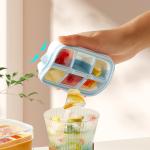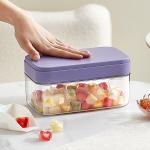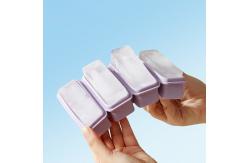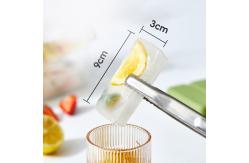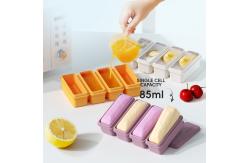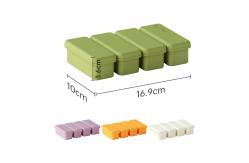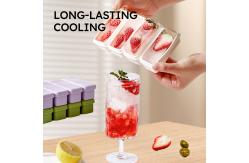| Specifications | |
| Product name | Fridge Ice Cube Tray |
| Model | GJ3126 |
| Color | Yellow,Pink,White,Blue |
| Size | 16.9*10.05*3.6cm |
| Material | Silicone |
| Usage | Ice make |
| Application | kitchen |
| MOQ | 500pcs |
| Style | Simple, modern, retro, casual |
| Packing | Color Box |
FAQ
Q1:Are you factory or trading company?
A:We are a factory specializing in the production of household
products with export certificates.
Q2.what's the advantage?
All products are independently developed and patented.
Q3:What's the order process?
A:1)Inquiry-provide us all clear requiremenis(total qty and package
details).
2)Quotation-official quotation form with all clear
specifications from our professional team.
3)Making Sample - confirm all quotation details and the final
sample.
4)Payment terms.
5)Production-mass production.
6)Shipping- By sea or by air.
Q4.:What payment methods do you available?
A:Normally we use Alibaba Trade Assurance deal with payment. But it
could be discussed.
Q5:Can you accept customized product?
A:Yes, We can make according to customers'requirement We'd like to
develop new products with customers.
Q6:What is the difference between silicone ice cube trays and plastic
ice cube trays?
A:The main difference between silicone ice cube trays and plastic ice
cube trays is the nature and safety of the materials. Silicone is
flexible at room temperature, while plastic is generally hard at
room temperature.
This means that silicone ice cube trays may offer better
flexibility and durability because they can more easily remove ice
cubes from the mold and are not easy to break or damage.
In addition, food-grade silicone is considered a safer material.
This means that ice cube trays made of silicone are safer for
contact with food and beverages because it does not release harmful
substances like some plastics. The use of food-grade silicone
ensures that the product is safe for direct contact with food,
which is especially important for ice cubes that need to be stored
or frozen for a long time.
Silicone ice cube trays have obvious advantages over plastic ice
cube trays in terms of flexibility and safety.
Q7:What is the specific material composition of silicone ice cube
trays?
A:The specific material composition of silicone ice cube trays is
silicone.
Q8:What is the difference in performance between food-grade silicone
and ordinary silicone?
A:The main differences in performance between food-grade silicone and
ordinary silicone are reflected in the following aspects:
Safety and non-toxicity: Food-grade silicone usually does not
contain bisphenol A, is safe and non-toxic, and is suitable for
direct contact with food and beverages. For example, the food-grade
liquid silicone used in the "Little Dot" silicone bottle is a safe
and non-toxic material.
High temperature resistance: Food-grade silicone can withstand
higher temperatures, such as high temperature sterilization at 200
degrees Celsius, which makes it very useful in applications that
require long-term high-temperature treatment.
Chemical stability and compatibility: Food-grade silicone has good
chemical stability and is well compatible with a variety of
materials (such as various rubbers, plastics, etc.), which enables
it to adapt to different working environments and requirements
during the manufacturing process.
Certification standards: Food-grade silicone products usually pass
strict certifications, such as FDA food grade certification,
GB4806.11 food contact material certification and USP Class VI
certification, which ensure its safe use in the food and beverage
industry.
In contrast, ordinary silicone may not have these specific
food-grade certifications, and its chemical composition and safety
may not be as strict as food-grade silicone. In addition, ordinary
silicone may not be suitable for application scenarios that require
high safety and high temperature resistance.
Q9:What are the common harmful substances in plastic ice cube trays,
and what are their potential effects on human health?
A:Common harmful substances in plastic ice cube trays mainly include
phthalates, perfluorinated compounds, brominated flame retardants
and dioxins. The potential effects of these substances on human
health are as follows:
Phthalates: This type of substance is widely found in plastic
products, including food packaging and household appliances. They
can enter the human body through breathing, digestive tract and
skin contact, and have adverse effects on the reproductive system,
nervous system and immune system. Long-term exposure may cause
diseases such as cancer, diabetes and obesity. In addition, DEHA
(di(2-ethylhexyl) phthalate) is an endocrine disruptor that
interferes with the normal production and regulation of hormones
and is particularly harmful to developing infants and children.
Perfluorinated compounds: These compounds are persistent and
bioaccumulative, and can be transmitted through the food chain and
eventually enter the human body. They may cause damage to the
liver, immune system and endocrine system, and increase the risk of
cancer.
Brominated flame retardants: These chemicals are used as flame
retardants in plastic products, but they are also harmful to human
health. They may cause respiratory problems, skin irritation, and
immune system dysfunction.
Dichlorobenzene: This is a toxic organic pollutant produced by the
combustion process. When present in plastic products, it may enter
the human body through breathing and skin contact. It has
significant toxic effects on the liver, immune system, and
reproductive system, and is a known carcinogen.
Microplastics: Although the main discussion is about large plastic
particles, microplastics are also a health hazard that cannot be
ignored. They may carry heavy metals, toxic chemicals, and other
pollutants, which may cause damage to the digestive system and
immune system after entering the human body, and even affect
nutrient absorption and increase the risk of cancer, neurological
diseases, etc.
Therefore, in order to protect your own health, it is recommended
to minimize the use of plastic products containing the
above-mentioned harmful substances and choose non-toxic or
food-grade alternatives, such as safe materials such as
polyethylene and polypropylene.
Q10:In long-term use, how does the durability and safety of silicone
ice cube trays compare with plastic ice cube trays?
A:When comparing the durability and safety of silicone ice cube trays
and plastic ice cube trays, we can analyze them from two aspects:
the physical and chemical properties of the materials and the
environmental impact.
From the perspective of physical and chemical properties, silicone
rubber has excellent heat and cold resistance. According to
, silicone rubber can withstand high temperatures up
to 150°C and still maintain its flexibility under extreme
conditions (such as -60°C to -70°C), which shows
that silicone performs well under extreme temperatures. In
addition, the durability of silicone rubber is also enhanced, and
softening under high-temperature sealing conditions can be
prevented by adjusting the formula and using different curing
agents. In contrast, plastic materials generally do not have such a
temperature resistance range and stability, especially in high or
low temperature environments, they may have problems with
deformation or embrittlement.
From the perspective of environmental impact, although stainless
steel containers have a greater impact on the environment than
plastic containers when their service life reaches five years, this
does not directly apply to comparing silicone and plastic ice cube
trays. However, it can be speculated that since silicone is an
organic synthetic material, its production and disposal may require
more attention and management to ensure environmental safety.
Silicone ice cube trays perform better in terms of durability and
safety, especially in terms of temperature resistance, which is
better than plastic ice cube trays.
Q11:How to properly clean and disinfect silicone ice cube trays to
ensure food safety?
A:To ensure the cleaning and disinfection of silicone ice cube trays
to ensure food safety, you can follow the following steps:
Remove obvious stains: First, use a soft cloth or sponge dipped in
warm water or a neutral detergent to remove obvious food residues,
dirt or other debris from the tray.
Use appropriate detergents and friction: Choose an appropriate
detergent (such as household detergent) and use appropriate
friction (such as a soft sponge) to remove remaining stains. Be
careful not to use detergents containing abrasives, acids or
chemical solvents to avoid damaging the surface of the tray.
Rinse thoroughly: Rinse the tray thoroughly with hot water to
remove all detergent residues. Make sure to rinse thoroughly to
avoid any detergent residue that may contaminate the food.
Sanitize: For surfaces that come into direct contact with food,
cleaning alone is not enough, and disinfection is also required.
The tray can be soaked in a disinfectant solution for at least 1
minute, then removed from the solution and air dried. Common
disinfection methods include using 70% alcohol, isopropyl alcohol
or 6% H2O2.
Regular maintenance and inspection: Regularly inspect and replace
the water filter element of the ice maker, and regularly clean and
maintain the ice maker according to the manufacturer's instructions
to ensure its normal operation and prevent contamination.
The above steps can effectively clean and disinfect the silicone
ice cube tray to ensure food safety.

